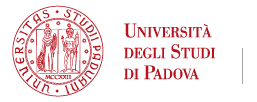
Guidelines
Facility Regulation
1. Access to the iPSC Facility is allowed only to authorized persons: it is therefore forbidden to introduce unauthorized persons without first contacting the managers of the facility (Prof. Milena Bellin, and prof. Graziano Martello).
2. Access to the facility is allowed only after an introductory session held by Dr. Evgenii Lysenko. Bachelor’s students can access the Facility only if accompanied by an authorized and trained person.
3. The facility works from Monday to Friday from 8 a.m. to 6 p.m. If additional time slots besides working time is needed Dr. Evgenii Lysenko must be informed; please keep in mind that no technical assistance is guaranteed outside working hours. Last user in the booking system must switch off lightning, water bath and microscope, check if all hoods and incubators are closed before leaving the facility.
4. Minimal booking slot for the hoods is 1h, maximal booking time for one person per day is 4h. If more time is needed this can be done by Dr. Evgenii Lysenko after preliminary consideration. Slots cancellation is allowed up to 24 hours before. Later cancellations or no show up will result in charging of the full rate.
5. It is mandatory to wear lab coats and gloves inside the facility. Lab coats must be worn exclusively in the facility. Each user should have 2 lab coats, as every 3 weeks 1 lab coat will be sent for cleaning.
6. At the beginning of their reservation all users must check all the equipment and immediately inform Dr. Evgenii Lysenko if any damage is noticed. Unnotified damages will be ascribed to the last user in the booking system.
7. New cell lines can be used in the facility only after preventive mycoplasma test.
8. All cell lines used in the facility need to be registered in a designated form, and they will be tested for mycoplasma once per month. This is mandatory, refusing to provide pellets for the test, will result in the ban of the user from the facility.
9. It’s not allowed to carry plates from other culture rooms to the facility. Similarly, any plate that was taken out of the facility cannot re-enter the facility. Exceptions due to cell sorting or transduction in BSL-2 need to be discussed with the Facility manager.
10. All users are required to monitor the status of their cells. Events of contamination must be immediately reported to Dr. Evgenii Lysenko by email.
11. It’s mandatory to UV the hood for 15 minutes before starting to work to ensure cleanliness of the surfaces and plastic consumables. Each user has to bring their own plastics; the facility will provide storage space.
12. After work, the hood must be thoroughly cleaned and cleared for the next users. It’s not necessary to start UV as it will be the responsibility of each user to UV the hood at the beginning of their reservation.
13. The training for expansion, passaging, freezing and thawing of human PSCs must be performed using validated cells and reagents, that can be purchased from the facility.
Rules for proper aseptic techniques
INTRODUCTION
Microorganisms causing the contamination problems exist everywhere, on the surface of all objects, on the skin of all people, and in the air. A conscious effort must be made to keep them out of a sterile environment.
STERILE TECHNIQUES
- Wash your hands before starting with cell culture work (especially after eating) and use gloves and wear a lab coat.
- Before and after use, the working surface (LAF-Hood) should be disinfected thoroughly with 70% ethanol (clean also under the liquid waste bottles) and spray the tube-rack. (The surrounding areas and equipment should be cleaned routinely).
- Rinse the liquid waste tube connected to the liquid waste bottle after use with:
- First SDS 1%
- Then 70% ethanol
- In case you spill some liquid in the hood, clean right away with 70% ethanol
- Spray with EtOH 70% the outside of bottles, flasks and tubes before placing them in the cell culture hood (but in principle everything that goes under the sterile hood: pipettes, racks…). This is especially important when coming from the water bath.
- The work surface should be uncluttered and contain only items required for a particular procedure; it should not be used as a storage area. Put your tube- rack, flasks and or bottles you have to use at the back of the hood, so that you will have a suitable working space.
- Techniques should be performed as rapidly as possible to minimize contamination.
- Avoid pouring media and reagents directly from bottles or flasks
- Use disposable plastic pipettes and a pipette-boy to work with liquids, and use each pipette only once to avoid cross contamination. Do not unwrap sterile pipettes until they are to be used. Keep your pipettes at your work area.
- Never touch the outside of a tube with the pipette – if you do so, then discard it and change pipette
Avoid touching the inside of tubes, tissue cultureware, etc. with the outside of the plastic pipettes.
Aspirate any liquid left in the neck of tissue culture flasks or on the lids of dishes.
- Never uncover a sterile flask, bottle, petri dish, etc., until the instant you are ready to use it. Return the cover as soon as you are finished. Never leave it open to the environment.
- When removing a cap or cover, do not place the cap with the open-end upright on the lab bench but with the open-end facing down.
- Be careful not to talk, sing, or whistle when you are performing these sterile procedures.
- When opening a bottle/dish, never pass over with anything (objects or arms/hands).
- When you are using the liquid waste aspiration system (add 200ml 3M KOH to every clean bottle), be sure that before you start with aspiration, 1) first press the pedal for aspiration and 2) hold the tube with the Pasteur pipette downwards, otherwise remaining liquid in the tube can drop into your plate or flask with medium/ cells.
- When aspirating medium from a T175 flask, use a 2 ml sterile pipet (brake and discard the upper part with the cotton tip) and connect this pipette to the aspiration tube.
- Use Pasteur pipettes (pre-flamed) only for one aspiration handling to avoid cross- contamination.
- Avoid excessive use of the flame as this disrupts the airflow in the hood.
- The liquid waste container/ flask should never be filled more than about 850 ml. (ML-I/ T01-026). When this volume is reached, take care of replacing with a new bottle (after adding 200 ml 3M KOH to this) and close the full one and collect for the autoclaving cleaning.
- When you discard tissue culture plates or dishes that cannot be closed properly, aspirate the remaining medium and discard in the blue box
- Open bags containing dishes/plates under the hood – then close it with tape – and only after that put it back in a drawer
- Tubes / flasks / freezing tubes – should be kept in a bag and not open air
- Avoid talking/singing/whistling when the incubator is open.
Movie
http://www.youtube.com/watch?v=yJ_acpKglto





